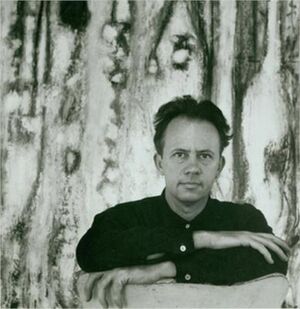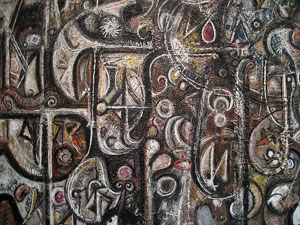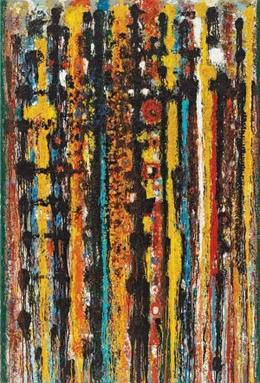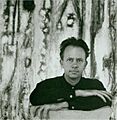Richard Pousette-Dart facts for kids
Quick facts for kids
Richard Pousette-Dart
|
|
|---|---|
 |
|
| Born |
Richard Warren Pousette-Dart
June 8, 1916 |
| Died | October 25, 1992 (aged 76) |
| Nationality | American |
| Education | Abstract painting |
| Movement | Abstract expressionism, New York School |
Richard Pousette-Dart (born June 8, 1916 – died October 25, 1992) was an American artist. He was famous for his abstract expressionist paintings. He also helped start the New York School of painting. Besides painting, he created drawings, sculptures, and amazing photographs.
Contents
Early Life of an Artist
Richard Pousette-Dart was born in Saint Paul, Minnesota. His family moved to Valhalla, New York in 1918. His mother, Flora Louise Pousette-Dart, was a poet and musician. His father, Nathaniel J. Pousette-Dart, was a painter and art teacher. His parents combined their last names when they got married.
Richard started painting and drawing when he was just eight years old. A newspaper even showed him and his dad drawing each other. He went to Scarborough School. Even as a teenager, he had strong ideas about abstract art. He believed that great art should be abstract. It should show feelings that everyone can understand, not just one person's feelings. He went to Bard College for a short time in 1936. But he soon left to become an artist in New York City. He worked as an assistant to a sculptor named Paul Manship. He also worked in a photo retouching studio.
Richard Pousette-Dart's Art Career
Richard Pousette-Dart first focused on carving stone. Later, he also worked with bronze and brass. He admired the artist Henri Gaudier-Brzeska. Gaudier-Brzeska used tribal art to show power and mystery. In the 1930s, Richard often visited the American Museum of Natural History. He became very interested in art from Africa, Oceania, and Native America. He especially liked carvings from Northwest Indian cultures. Many of his early paintings and sculptures show these symbolic shapes. An example is Woman Bird Group at the Smithsonian American Art Museum.
In 1938, Richard became friends with John D. Graham. Graham's ideas helped him understand European art styles. These included Cubism and Surrealism. These styles were being shown in New York City. Graham also liked "primitive" art forms. Richard then made paintings with complex, connected shapes. He also drew hundreds of simple, abstract figures and animals.

First Exhibitions and Big Paintings
Richard Pousette-Dart had his first art show in New York in 1941. This was a year after he finished his painting Desert. In 1942, he completed Symphony No. 1, The Transcendental. This painting was very large. It was too big for the gallery where it was supposed to be shown. This work was the first very large painting by the New York School artists. It influenced other famous artists. These included Jackson Pollock's Mural and Arshile Gorky's The Liver is the Cock's Comb.
During the mid-1940s, Richard showed his art at several galleries. These included Peggy Guggenheim's Art of This Century. In 1948, he joined the Betty Parsons Gallery. This gallery showed the work of other important artists. These included Mark Rothko, Jackson Pollock, and Barnett Newman. These artists helped shape the New York School style.
New Studios and Styles
In the late 1940s, Richard's studio was in Manhattan. It was near the Queensboro Bridge. His "East River Paintings" from this time show thick lines. He often put paint directly from the tube onto the canvas. He also used sand, poured paint, and gold or silver leaf.
In 1951, Richard moved to a farmhouse in Sloatsburg, New York. Later, he moved to Suffern, New York. He kept a studio there for the rest of his life. In 1951, he also won a Guggenheim Fellowship for Fine Arts. This award helped him continue his art.
Throughout the 1940s and 1950s, Richard tried many different art materials and methods. He made paintings that were very full of color and texture. He also made simpler works. His "Gothic and Byzantine" paintings used thick layers of paint. They had bright, shining colors. They looked like old illuminated books or stained glass windows. Savage Rose from 1951 is an example of these thick paintings. In contrast, his "White Paintings" were light and airy. They used graphite lines on white backgrounds.
Later Works and Exhibitions
Starting in the late 1950s, Richard began to build shapes with small dots of color. This created paintings that looked like fields of color. By the 1960s, he made large works with thick layers of these marks. They seemed to glow and pulse. Paintings called "Hieroglyphs" and "Radiances" showed dense fields of color. They had shapes that seemed to appear and disappear. In the 1970s and 1980s, his works often had large circles or geometric shapes. These shapes were like central points in the art. He used many bright colors. But he also explored themes using only black and white.
In 1950, Richard drew pictures for a book called Taos Quartet in Three Movements. This book was about the lives of famous writers and artists. It was the only book Richard illustrated.
Richard Pousette-Dart continued to show his art at the Betty Parsons Gallery. This helped younger artists see his work. These artists included Ellsworth Kelly and Robert Rauschenberg. In 1963, The Whitney Museum of American Art held Richard's first big art show. They had more shows of his work in 1974 and 1998. In the 1970s, Richard worked in Europe. He focused on watercolor paintings there. In 1990, his biggest art show was held at the Indianapolis Museum of Art. For this show, he made a large bronze door called Cathedral. It is still there today.
Photography as Art
As a child, Richard Pousette-Dart experimented with cameras. By the mid-1940s, he became a very active fine-art photographer. His photos were first shown at the Betty Parsons Gallery in 1948. In 1953, he won an award in a photography contest. He also had his own photo show in New York City.
Richard's art photography mainly focused on portraits and nature. He took pictures of famous artists like Mark Rothko and Barnett Newman. Many of his portraits were experimental. He used techniques like double-exposure. This means taking two pictures on one film. He did all the darkroom work himself. His nature photos were often close-up views of plants or ice. These photos shared ideas with his paintings.
Teaching Art to Others
Richard Pousette-Dart also taught art. One of his first students was Saul Leiter. Saul came to New York to study painting with Richard. But he was so impressed by Richard's photos that he became a photographer himself.
From 1950 to 1961, Richard taught painting at the New School for Social Research. He also taught at Columbia University and Sarah Lawrence College. Later, he taught at the Art Students League and Bard College. Some of his famous students included the Chinese artists Ai Weiwei and Zhang Hongtu. Christopher Wool studied with Richard at Sarah Lawrence College. Christopher said that Richard encouraged students to find their own answers. He wanted them to discover their own way of making art.
Personal Beliefs and Family
Richard Pousette-Dart believed strongly in pacifism from a young age. This means he believed in peace and was against war. In high school, he wrote an essay called "I Have Been Called a Dreamer." It called for peace. During World War II, Richard refused to join the army. He sent letters protesting the war. He was not punished for his beliefs.
Richard Pousette-Dart married a poet named Evelyn Gracey in 1946. Their daughter, Joanna Pousette-Dart, is also an abstract painter. She lives and works in New York City. His son, Jon Pousette-Dart, is a musician. He started The Pousette-Dart Band.
Richard Pousette-Dart's Legacy
Richard Pousette-Dart passed away on October 25, 1992, in New York City. After his death, many exhibitions honored his work. In 1997–1998, The Metropolitan Museum of Art held a big show of his art. In 1998, the Whitney Museum of American Art recreated his studio for an exhibition. Other major shows took place in Germany, Italy, and Washington, D.C.
In 1965, Richard received an honorary degree from Bard College. In 1981, he won an award for his lifetime achievements in art. His work was also shown at the 40th Venice Biennale in 1982.
The Richard Pousette-Dart Foundation was started in 2013. This foundation helps keep his art and ideas alive. His art is now represented by The Pace Gallery. In 2019, Richard Pousette-Dart's house and studio in Suffern, New York, became a historical place.
Images for kids



